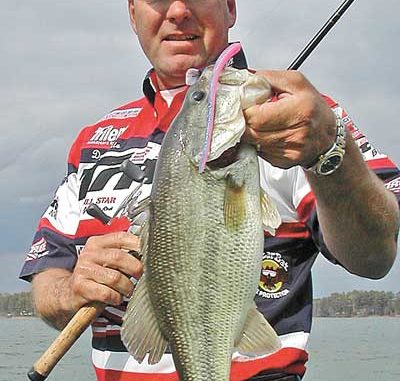
As a tournament fisherman, I try not to get caught up in the old saying, “Catching one bass on topwater is better than catching four or five on a worm.”
When you’re making your living fishing, you have to fish the lure that will catch the most fish. On the other hand, it is true: seeing a fish explode on a surface lure is something you just love. It’s the neatest thing about bass fishing.
I bring this up because October is a great month to catch bass on topwater baits. When the leaves start falling, it’s a good time to fish a topwater bait.
Typically, we don’t get a real good frost until November, and the water starts to cool off in October, so you have a period of a few weeks where the water temperature is just right for a fish to feed at the surface.
You can topwater fish over a lot of different depths, depending on the kind of lake you’re fishing or even a specific area. In lakes where the water is real stained or tannic — or in the back of a silted-in creek where you have low visibility — you should be fishing over no more than five feet of water.
On the other hand, on the lower end of a lot of our bigger reservoirs, like Murray, Santee, Clarks Hill and Hartwell, the water clarity is really good, and in that situation, I’ll fish a topwater over as much as 10 to 20 feet of water. You might be fishing over a long shoal or a hump or a ridge, but those fish will come a lot way to a bait in clear water because they can see it better.
When I put my boat in the water this month, I’ll usually have a half-dozen rods rigged with topwater baits. I’ll have a buzzbait on one rod, a couple of floating worms on rods, and three more rods rigged for plugs: a stickbait, a popper-type bait and a prop bait. That’s what I start with, and I fish them until the fish tell me what they want. That can change from day to day, and in the course of a day.
As far as colors go, if I’m fishing in clear water, I like brighter colors, especially the floating worms. I’ll go with orange or bubble gum or chartreuse or white. In tannic or dark water, I’ll go with darker colors like merthiolate — but with a little fluorescent in there — maybe a bit of chartreuse. I like “ghost minnow” colors on plugs.
When you’re fishing topwater baits, you want to have monofilament spooled on your reel. I love fishing Trilene 100 Percent Fluorocarbon, but fluorocarbon is just not what you want to have a topwater bait tied to, because it’s heavy and will sink a little, which can keep your bait from working like it’s supposed to. Normally, I’ll be fishing a 6½-foot medium action All-Star rod, one with a light tip. I’ll spool on Trilene XT or Trilene Big Game mono in 14- to 17-pound. I also make sure that I use a loop knot to tie on all of my topwater baits — at least the plugs. A standard knot will restrict a bait’s action just a little bit; a loop knot won’t.
If I’m fishing a topwater bait over deeper water, I’ll keep an eye on my depthfinder for anything that shows up between 15 and 20 feet deep — shad or bass. One neat thing is, if you catch a fish, he’s likely got a group of fish down there with him. When you’re fishing a topwater bait shallow around cover, there’s probably just one fish on that piece of cover.
A floating worm or a buzzbait works real well fished over dying lily pads or over hydrilla and milfoil. With a buzzbait, you can cover so much more water, even if it is a more target-oriented bait. You can fish a buzzbait, a floating worm or a popper around docks or shallow cover like brushpiles. That popper, you’ll have to fish it so slowly — bloop, bloop, stop, wait five seconds, bloop, bloop. A lot of guys get caught up in the rhythm, and they don’t realize they’ve spent a half-day fishing a quarter-mile stretch of bank.
I like to take off the rear hook on a popping bait or a walking bait and replace it with an Owner feather hook, because you’ll find a lot of times — especially in a real, clear-water situation — a bass will come up and just slap at a bait and not eat it. The water is so clear, and the fish is coming so far to get it, that he gets a real good look at it, and at the last second, he decides not to eat it. A feather hook is sometimes all you need to get that fish to commit at the last second to eat the bait.
Part of the allure of fishing topwater baits in the fall is that the weather is so nice; it’s just a really good time to be on the water. Plus, you’ve got a lot less fishing pressure. A lot of guys are into high school football and deer hunting, and you’ve got almost no recreational boats on the lake, no jet skis, and that’s great.
October is just a great time to be on the water, and catching a nice bass on a topwater bait makes it even better.




Be the first to comment